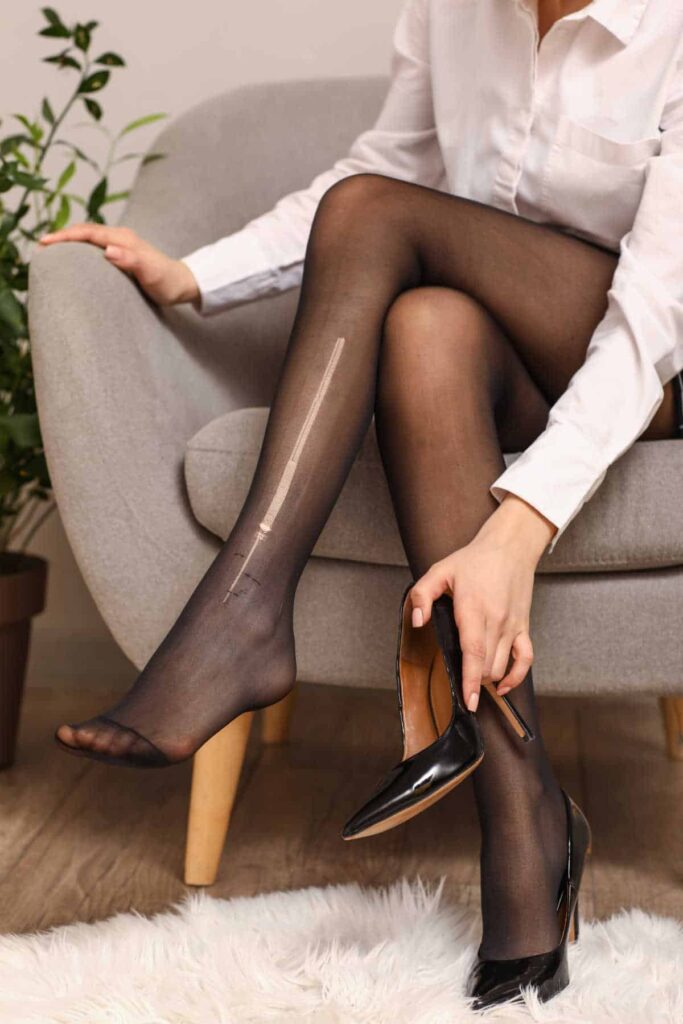Are Clothes Made From Recycled Plastic Eco-Friendly?
To support the running costs of Moral Fibres, this post may contain affiliate links. This means Moral Fibres may earn a small commission, at no extra cost to readers, on items purchased through these links.
Many fashion brands are now making clothes from recycled plastic. Brands claim this is a greener option. However, is making clothes from recycled plastic really eco-friendly? Let’s take a deep look into the recycling clothing industry.
Many fast fashion brands have switched to using materials such as BCI Cotton and polyester made from recycled plastic bottles to convince us of their ethical credentials.
I’ve already taken a deep look into BCI Cotton and found it isn’t particularly sustainable or ethical. In fact, it is significantly reducing the demand for organic cotton.
With that revelation in mind, I’ve taken a look into clothing made from recycled plastic bottles to see if this option is any more sustainable or eco-friendly. Or if fast-fashion retailers are trying to pull the (fake) wool over our eyes.
How Are Clothes Made Out of Plastic Bottles?
Firstly, you might wonder how plastic bottles are transformed into recycled polyester clothing.
Those empty plastic bottles you toss into recycling bins start their journey by being broken down into small plastic flakes. Next, these flakes undergo a melting process, turning them into tiny pellets of plastic. These pellets are then heated up and spun into threads, ready to weave their way into various types of clothing in place of virgin polyester.
These threads aren’t your typical stiff plastic strands. Before being transformed into fabric, the threads go through a crimping machine, which creates a soft, woolly texture. So instead of feeling like you’re wearing hard plastic, your recycled polyester clothes have that cosy, fluffy feel.
Virgin polyester is a synthetic fabric made from fossil fuels like crude oil and natural gas. It’s not exactly the poster child for sustainability. So, swapping out virgin plastics for recycled ones seems like a no-brainer, right? It’s a bit more complicated than that I’m afraid.
Are Clothes Made From Recycled Plastic Actually Eco-Friendly?

Unsurprisingly, fast fashion brands are trying to fleece us. This is because there are several issues when it comes to making clothes out of recycled plastic bottles. Use the links to jump to a specific section or keep scrolling for the full guide:
The Impact of Downcycling
The process of turning plastic bottles and other plastic waste into clothing is commonly known as downcycling. Why? Well, because once your old bottle gets transformed into a polyester top or leggings, then it can’t go back to being a bottle again. Or anything else for that matter. Once plastic is recycled into clothing, it’s a one-way ticket to landfill.
Plastic bottles, on the other hand, can be recycled multiple times and reincarnated into new bottles. This means that diverting plastic bottles away from the recycling loop that keeps them circling back as, well, more bottles, the fashion industry inadvertently puts pressure on the plastic bottle industry. With fashion brands snapping up plastic for their unrecyclable clothing, the bottle industry finds itself turning to virgin plastic to fill the void.
So, while recycling plastic into clothing might seem like a win for sustainability at first glance, the reality is a bit more complex.
Isn’t There More Than Enough Plastic To Go Around?
You might be wondering what the big deal is with clothing made from recycled plastic. Are there not tonnes of plastic bottles in circulation – more than we can actually cope with? The fashion industry can’t make that much of a dent in the amount of plastic available, surely?
Undeniably, yes, there is a plastic mountain. However, not all plastic is created equally.
Plastic bottles are made from a type of plastic called PET – polyethylene terephthalate. PET is a clear, strong, and lightweight plastic that can cope with being recycled multiple times. In fact, it is the world’s preferred packaging material for foods and beverages. As such, it is the world’s most recycled plastic. This type of plastic generally isn’t sent abroad for disposal. Instead, it is being recycled and used – unlike other lower-grade plastics.
When it comes to clothing, using recycled polyester instead of virgin polyester does sound like a good idea. The issue when it comes to clothing is scale. H&M boasts that 90% of its recycled polyester comes from plastic bottles. Yet H&M alone produces 3 million items of clothing a year.
And that’s just one fast fashion giant. When you multiply that by the likes of Primark, Next, BooHoo, and the many other fast fashion brands jumping on the recycled plastic bandwagon, then we are talking about an awful lot of potentially recyclable plastic bottles being taken out of a closed-loop plastic bottle recycling system. Instead of coming full circle as bottles again, they’re getting a new lease on life as non-recyclable clothing.
The Fast Fashion Problem
One of the many issues with fast fashion is that shoppers wear an item of clothing just a few times before they are passed on to charity shops. While charity shops are absolute gems for finding preloved treasures, when they’re inundated with mountains of cheap clothing that nobody wants, it’s a whole different story.
When our charity shops are overrun by clothing which they can’t sell, it gets sold off to developing countries. Here it is chopped up into rags, sold on at markets, or thrown into landfill.
Even if those clothes were made from recycled plastic bottles, the sheer volume of our clothing consumption is a sustainability nightmare. It’s like trying to plug a leaky boat with a plaster – it might help in the short term, but we’re still sinking.
The Microplastics Issue
One of the other main problems with clothing made from plastic, whether virgin plastic or recycled plastic, is that they release microplastics when they are washed. Researchers have scarily found that laundering synthetic clothing is the main source of microplastic in our oceans.
Microplastics are what we call fragments of any type of plastic less than 5 mm in length. Sometimes these are visible to the human eye, other times they are so small that they cannot be seen. While we can’t always see them, these tiny pieces of plastic wreak havoc on the environment – contaminating oceans, waterways and our soils.
Scientists have uncovered that microplastics make their way into our food chain, ending up on our plates and ultimately in our bodies. While scientists are still unraveling the full extent of their impact, early studies suggest they can damage our cells and bodies in ways we’re only just beginning to understand.
While fast fashion retailers are quick to tout the eco-friendly virtues of clothing made from recycled plastic, they’re conveniently sweeping the microplastic issue under the rug. Instead, fast fashion retailers are continuing to sing the praises of clothing made from recycled plastic. I have found not a single example of a fast-fashion retailer educating consumers on some of the issues associated with synthetic clothing.
And what’s worse is that H&M has no plans to decrease the amount of clothing it intends to produce. Instead, it is planning to double sales by 2030. You simply cannot be an ethical retailer and sell 6 billion items of clothing a year – no matter how many items of clothing you make from plastic bottles.
What Should I Buy Instead?

If you are wondering what to buy instead of fast fashion clothing made from recycled plastic bottles, then there are lots of other sustainable choices you can make:
- The first is not buying anything you don’t need. The most sustainable items of clothing are the ones you already own. Re-wearing your clothes again and again, looking after them, and fixing them if they rip is 100% the most sustainable solution.
- If you need new clothes, try swapping with your friends, or taking part in an organised clothes swap.
- Shopping secondhand is also a great sustainable option, that’s low impact.
- If you do need to buy clothing made from recycled polyester, then opt for a style that you will wear again and again, so that it doesn’t end up in landfill after only a few wears.
- Finally, buying clothes made from natural fibres from sustainable clothing brands, where possible, is another environmentally friendly way of buying new clothes.
When Is Recycled Plastic A Good Choice When It Comes to Clothing?
In certain cases, clothing made from recycled plastic can be a good environmental choice. When it comes to swimwear, for example, it is not possible to make swimwear from 100% natural fabrics, and still have the properties that we expect swimwear to have.
In this case, look for swimwear made from ECONYL®. This is an innovative fabric that directly tackles plastic pollution in the ocean by taking nylon waste from carpet offcuts and discarded fishing nets, rather than plastic bottles. I have a full guide to ethical swimwear and swimwear made from recycled plastic to help you out.
Gym wear is another area where it is often tricky to find performance clothing made from natural fibres. In this case, the use of recycled plastics in these types of clothing is a better choice than using virgin plastic. I’m working on putting together a guide to ethical gym wear, so watch this space!
How To Wash These Performance Fabrics
One solution at the individual level is to wash your activewear in a product that catches microplastic, such as a Guppyfriend. The microplastics should then be discarded in the bin, rather than washing them down your sink.
To be honest, this action at the individual level is a sticking plaster for a wider issue. I’m more of a fan of interventions at the governmental and manufacturer level. This is because I don’t think this should be an issue for individuals to shoulder the responsibility or cost.
In the UK, the Government binned off the idea of installing microplastic filters on all new washing machines. Encouragingly though, Australia and California have recently announced plans to ensure that manufacturers must install microplastic filters on all new washing machines, as has France. Therefore, continuing to press on the Government for action on microplastics is key.
Another thing you can do to help limit microplastic release from your clothing is to gently hand wash your polyester pieces in cold water, rather than machine washing them. Line drying rather than tumble drying also helps limit microplastic shedding.
Found this post useful? Please consider buying me a virtual coffee to help support the site’s running costs.




